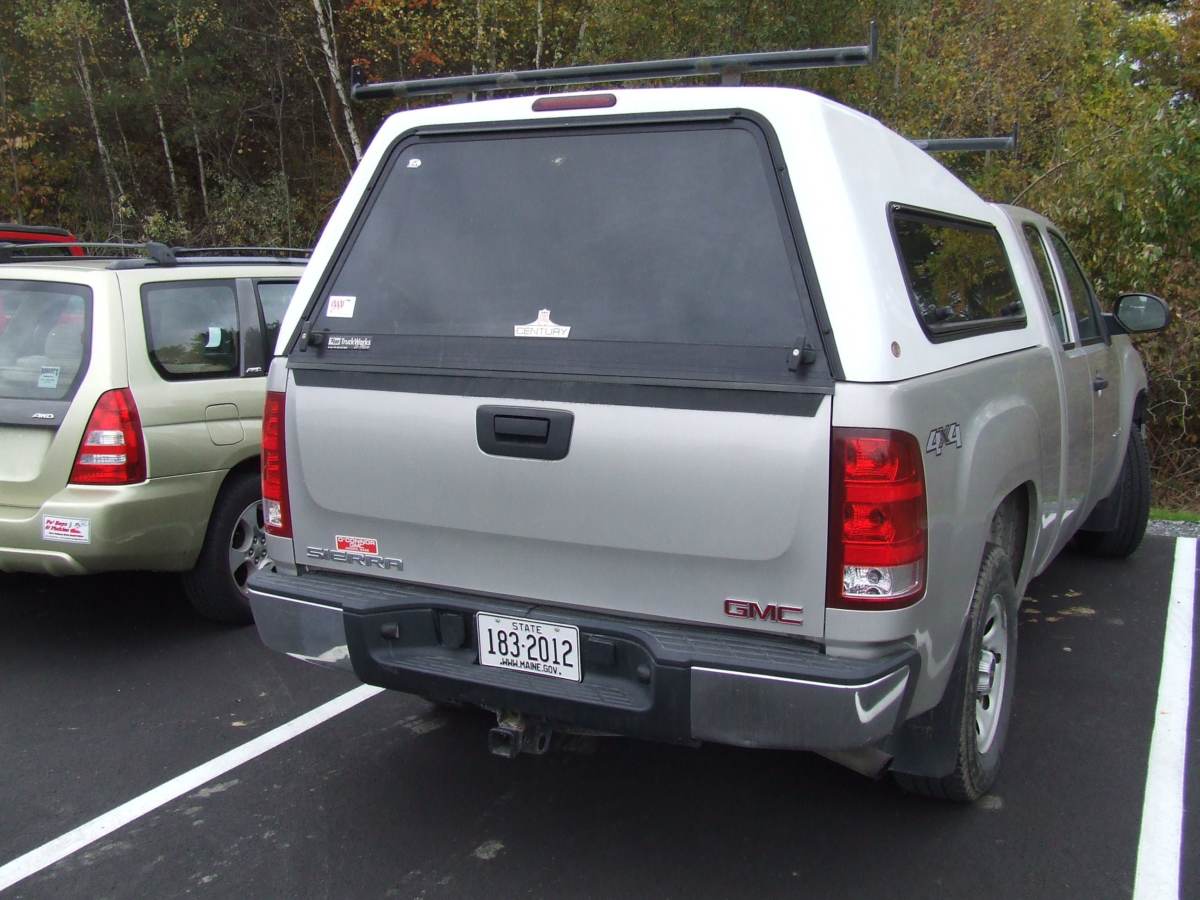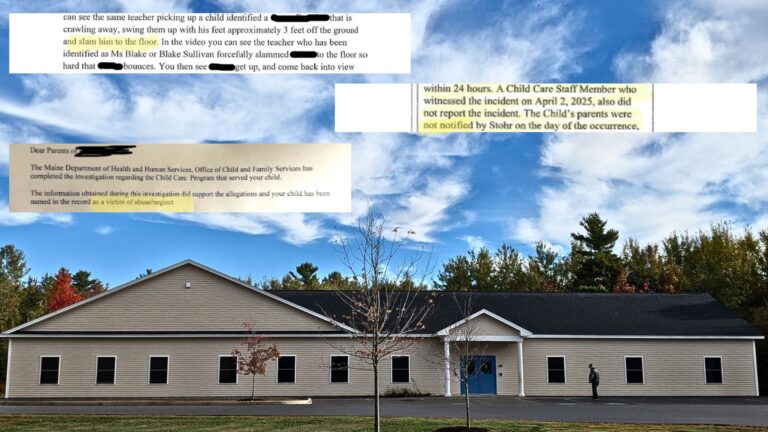Around 3:50 on the afternoon of Wednesday, Oct 12, a state-owned silver GMC Sierra pickup pulled into the parking lot at the Colby College rugby field.
A man in a blue windbreaker got out of the truck, took a cardboard box of equipment from the cab and headed down to the field, where members of the college’s men’s and women’s teams had gathered for their regular late afternoon practice.
The man was their coach.
But he is also the state dam inspector who has fallen years behind the legal schedule for safety inspections of the nearly 100 dams across the state categorized as potentially dangerous.
His name is Tony Fletcher, and he has held the paid rugby coach job at the private Waterville college since 2001, except for one semester, according to the college.
For seven or eight weeks each fall, four days a week, Fletcher leaves his Augusta office around 3:30 to drive the 19 miles to the campus for his coaching job, according to his boss at the Maine Emergency Management Agency (MEMA).
MEMA Director Robert McAleer said Fletcher also coaches the three-to-four-week spring rugby season, when practices are sometimes indoors in the evenings because of the weather.
Fletcher said he is paid $220 per week for his coaching contract with the college. His state salary is $56,800. With benefits, his total state compensation is $87,000.
In an email exchange with the Center last week, McAleer wrote, “I am aware that Mr. Fletcher coaches the Colby Rugby Teams on a part-time basis. Such work is neither prohibited nor discouraged.”
McAleer, stating he was also speaking for Fletcher, said Fletcher makes up the time spent coaching by coming in early or working nights or weekends.
However, Fletcher’s official time sheets do not show weekend work and do not specify what time he starts and ends his work days.
Fletcher said he doesn’t believe his coaching interferes with his state job, adding, “A request for a dam inspection would trump coaching and everything else in my life, except an emergency in my family.”
McAleer also said, in an email to the Center, that driving to a part-time job in a state vehicle was not authorized, and Fletcher has been told to stop.
Informed about the Center’s finding, Gov. Paul LePage’s spokesperson, Adrienne Bennett, said, “This particular matter is one MEMA staff is on top of, and I am confident the appropriate action will be taken if needed.”
Fletcher’s work schedule comes up at a time when questions have been raised about the productivity of the state’s dam inspection program. Until recently, Fletcher has been the only state inspector.
‘Loss of life’
On Aug. 14, the Maine Center for Public Interest Reporting published its findings following an examination of dam safety inspections reports provided to the Center by MEMA. The Center found that Maine is not living up to the state law that requires regular inspections of the 93 dams in the state classified as hazardous for their potential to take lives or sweep away buildings, roads and bridges.
Thousands of Mainers live below the potentially hazardous dams, from Sanford to Norway to Camden.
The state classifies 24 of the 93 dams as “high hazard potential,” meaning that a failure could “probably cause loss of life.” The other dams are “significant hazard dams,” meaning a failure could cause property or environmental damage.
Half of the high hazard dams are two to seven years overdue for their mandated inspection by a professional engineer, for example.
Of the 93 dams, the state could produce records showing only 10 percent have been inspected on time.
McAleer admitted to a legislative committee on Sept. 26 that the dams are not being inspected when the law says they should be. But he also said he was confident in the assurance he got from Fletcher that none of the dams pose a danger.
McAleer told the committee that completing safety inspections of the dams “at the rate specified in the law is virtually impossible” with one or two inspectors.
‘Do the math’
In an interview on Aug. 18, McAleer said, “Do the math on the whole numbers of dams that have to be inspected … It’s very difficult to keep up.”
But “the math” suggests it would be possible to keep up with the inspections if a dam was inspected about every week and a half.
With 93 dams that have to be inspected every two or four years, the math shows that if the state inspected 29-30 high and significant hazard dams each year, it would be right on target to meet the legal requirements.
Dam inspector Fletcher’s time sheets for 2010, the most recent full-year for which records are available, show he worked 230 days, eight hours per day. That means that if he inspected a potentially hazardous dam every week and half, he would meet the 29-30 annual inspections benchmark.
But the records supplied to the center for 2010 showed that only six of the hazardous dams were inspected during that year.
How many dams can be inspected in a year depends on whom you ask, and even then the answers are not precise.
Dana Murch, former supervisor of environmental regulation of dams for the state Department of Environmental Protection and co-author of the current dam safety law, said, “If one person can’t do 30 dams in one year, something is wrong.”
In an interview in May, Fletcher said “a full-on inspection can take a couple weeks. It ranges from that to just going in and eyeballing the situation.”
He later said in the same interview, “We look at about two (dams) a week. A lot of them are low hazard dams,” which must be inspected every six years.
A dam is classified as low hazard if a breach would damage only the owner’s property, not lives, roads, bridges or environmentally sensitive areas. In addition, national experts recommend that dam safety programs concentrate efforts on high and significant hazard dams.
McAleer, the MEMA director, was asked at a recent legislative committee meeting how long it typically takes to inspect a dam.
“I don’t know the answer to that,” he said.
Even if it took two weeks to inspect a dam, that would mean 26 could be inspected per year, very close to the benchmark needed to keep up with the law.
In an email, McAleer, replied:
“If all he (Fletcher) did was inspect dams, then one might expect that more than 6 inspections could be completed in a year. (It should also be noted that Mr. Fletcher has completed external inspections on approximately 9 other dams and is scheduled to complete the internal inspections when water levels will allow him to gain entry.) I have provided a list of Mr. Fletcher’s responsibilities that details the numerous duties his job entails. Mr. Fletcher must decide on a daily basis which of those numerous tasks are most important for him to do based on the priorities of the Agency. Given the fact that most of the State’s dams are in reasonably sound condition, spending time inspecting a healthy dam may not be as important as working with dam owners to ensure they have a workable Emergency Action Plan. The real crux of the matter, however, is in having a clear understanding of what a thorough dam inspection entails …”
The list provided by McAleer includes 24 “Job Tasks,” from conducting hazard classification inspections to ensuring that Emergency Action Plans are completed for the high and significant hazard dams.
Dams: safe or not?
McAleer’s statement that most of the state’s dams are in “reasonably sound condition,” however, is not in accord with previous statements by he and Fletcher.
In May, Fletcher said, “There are dams that are in poor condition. It’s very difficult to predict if a dam’s going to breach … There are no dams that I can say are in an imminent stage of failure, but it’s a very difficult call to make.”
Two months ago, McAleer said, “It’s incumbent on you to inspect them and see what their condition is. You can’t assume that a dam that was built 100 years ago is as solid today as it was 100 years ago.”
MEMA records shows 25 of the 93 hazardous dams are 100 years old or more.
Uncompensated hours
McAleer defended Fletcher’s work habits: “Tony is a unique individual who could probably make a lot more money who is also dedicated to this program. It’s phenomenal the times of day I get emails from him. We basically have to chase him out of the office.”
In his email, McAleer added, “Unlike many State employees, the nature of Mr. Fletcher’s position does not afford him the luxury of a regular 8-hour per day schedule. Because of travel requirements and the frequent necessity to meet with dam owners at their convenience, Mr. Fletcher very frequently works early in the morning, late into the night and on weekends … Because of this requirement, we are flexible with exactly what hours he works in the office.”
For example, he said on Oct. 12, one of the days Fletcher coached the rugby team, he worked 8.5 hours, not the eight hours on his time sheet, because he began work at 7 a.m. in Newport.
“Generally speaking,” McAleer wrote, “on practice days he will arrive at work early and/or return to work after practice. Given the tremendous number of non-compensated hours he works on a regular basis, any concerns about him working a full 40 hour work week are simply baseless.”
“This past weekend he worked over 7 hours on Sunday,” McAleer said, referring to Oct. 22-23. “All of those extra hours are uncompensated.”
The state car
McAleer estimated that Fletcher has used his state vehicle to drive to Colby “10 percent of the time or less.”
“Technically speaking, this is not an authorized use of the vehicle,” McAleer said. “Mr. Fletcher lives north of Waterville, so some might consider a slight detour to Colby ‘incidental’ use. However, we have taken steps to avoid such use in the future.”
Fletcher lives in Farmington. Driving from Augusta to Colby and then to Farmington adds another 20 miles to Fletcher’s trip home from the office in the state car.
McAleer said Fletcher is authorized to use the state vehicle to commute to his job because he “often leaves directly from home to do field work or returns late in the evening from trips.”
Lax approach not new
In McAleer’s defense of his program, he cites the improvements made in producing Emergency Action Plans (EAP) for the hazardous dam locations. The EAPs set out procedures in the event a dam fails, such as notification to downstream residents to evacuate.
But those plans improved only after media scrutiny.
“I believe we are running as strong a program as can be expected with the resources we have available and it is getting better,” McAleer wrote.
“As an example, in the last 5 years, EAP (Emergency Action Plan) compliance on State regulated High hazard dams has risen from around 5% to 100% and Significant hazard dams are now at 87%.”
But the state began improving its EAP program only after a news story by Kevin Wack in the Blethen Maine Newspapers in 2006 revealed that 71 percent of the high and significant hazard dams had no emergency plans or the plan expired.
Fletcher told reporter Wack the emergency plans are needed because, “A dam is like a loaded gun.”
McAleer, though, remains certain MEMA can do the job:
“I am confident that we have met the intent of the Legislature to ensure the safety of Maine’s citizens. And, we will continue to do so in spite of the challenges we face.”
Fletcher: MEMA ‘competent’ to do job
State dam inspector Tony Fletcher said he can inspect the state’s dams all year long.
“Yes the rugby season is a good time to inspect dams. Inspections can also be done in spring, fall and winter,” Fletcher wrote in an email to the Maine Center for Public Interest Reporting. “I plan to inspect … dams next week from Sunday to Saturday and it should go well.”
Fletcher wrote that he doesn’t keep track of how often he uses a state vehicle to travel to rugby practice.
“I do use my car as much as possible,” he said.
“You asked why I did not do the 29.25 inspections legally required per year. To this rate of inspection, the law requires that 500 low hazard dams be inspected for hazard every 6 years – or 83.3 inspections per year, amounting to 110 inspections a year,” Fletcher wrote.
“Then one must take into account admin costs, the upkeep of both the State and FERC (Federal Energy Regulatory Commission) databases and EAP’s (Emergency Action Plans) and training and travel. The latter is a most significant item to the general wear and tear of a human. Most private businesses operate at an efficiency of 40% or less when one takes all the other admin tasks into account to run that business. We are no different.”
At a legislative hearing in September, lawmakers responded to a statement by Fletcher’s boss that it was “virtually impossible” to do all the required engineering inspections of the state’s potentially hazardous dams by requesting that Fletcher and his staff at least conduct visual inspections of those dams.
Fletcher wrote that, “We are currently working flat out doing the 100 or so … dam general condition inspections for the legislature. We have currently done about 20 so far.”
“I believe we in MEMA are competent to carry out the dam safety for the State. Two full time administrative assistants and another engineer would go a long way to getting to our target. The real problem is the incessant travelling,” Fletcher wrote.









